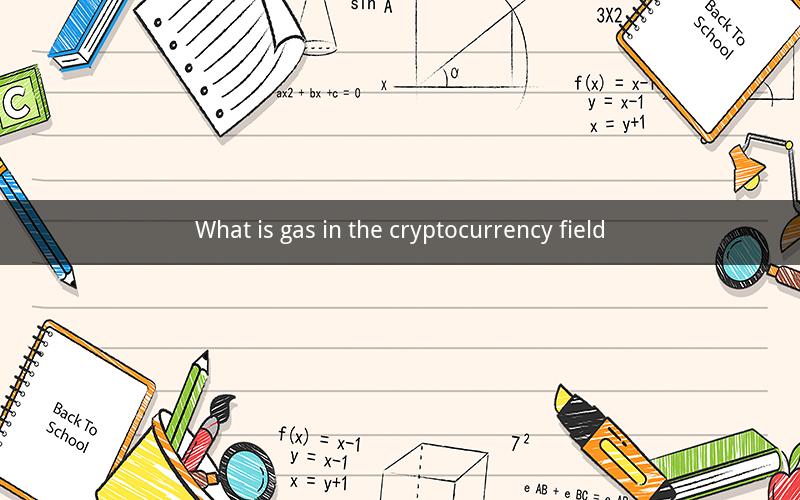
Table of Contents
1. Introduction to Cryptocurrency
2. The Concept of Gas in Cryptocurrency
3. How Gas Works in Cryptocurrency Transactions
4. Factors Influencing Gas Prices
5. The Role of Gas in Decentralized Applications (DApps)
6. Gas Limit and Gas Price in Ethereum
7. The Importance of Understanding Gas in Cryptocurrency
8. Gas Optimization Techniques
9. The Future of Gas in Cryptocurrency
10. Conclusion
1. Introduction to Cryptocurrency
Cryptocurrency is a digital or virtual form of currency that uses cryptography to secure transactions, control the creation of new units, and verify the transfer of assets. The first cryptocurrency, Bitcoin, was created in 2009, and since then, the cryptocurrency market has grown exponentially, with thousands of different cryptocurrencies emerging.
2. The Concept of Gas in Cryptocurrency
In the cryptocurrency field, gas refers to a unit of measurement used to pay for transaction fees on the blockchain. It is a concept that is primarily associated with Ethereum, one of the most popular cryptocurrencies. Gas is used to ensure that miners are incentivized to process transactions on the network.
3. How Gas Works in Cryptocurrency Transactions
When a user initiates a transaction on the blockchain, the transaction is divided into multiple operations, each of which requires a certain amount of gas to execute. The gas cost of a transaction is determined by the total number of operations and the gas price set by the user.
4. Factors Influencing Gas Prices
Several factors influence the gas prices in the cryptocurrency field. These include network congestion, demand for transaction processing, and the overall supply and demand dynamics of the cryptocurrency market.
5. The Role of Gas in Decentralized Applications (DApps)
Decentralized applications (DApps) are blockchain-based applications that run on the blockchain. Gas plays a crucial role in DApps, as it ensures that users are incentivized to participate in the network and maintain its decentralized nature.
6. Gas Limit and Gas Price in Ethereum
Ethereum is the most popular cryptocurrency platform that uses gas. In Ethereum, a transaction has a gas limit, which is the maximum amount of gas that the transaction can consume. The gas price is the amount of Ether that the user is willing to pay per unit of gas.
7. The Importance of Understanding Gas in Cryptocurrency
Understanding gas is essential for users in the cryptocurrency field, as it directly impacts the cost and efficiency of transactions. Users need to be aware of the gas prices and optimize their transactions to ensure the best possible outcome.
8. Gas Optimization Techniques
There are several techniques that users can employ to optimize their gas usage and reduce transaction costs. These include minimizing transaction size, using efficient contracts, and choosing the right gas price.
9. The Future of Gas in Cryptocurrency
As the cryptocurrency market continues to evolve, the concept of gas may undergo changes. With advancements in technology and the emergence of new platforms, the role of gas may shift, but its importance in the cryptocurrency field is expected to remain.
10. Conclusion
Gas is a crucial concept in the cryptocurrency field, particularly in Ethereum. Understanding how gas works and its impact on transactions is essential for users to make informed decisions and optimize their gas usage. As the cryptocurrency market continues to grow, the importance of gas is likely to increase, making it a key area of focus for users and developers alike.
Questions and Answers:
1. What is the primary purpose of gas in cryptocurrency transactions?
Gas is used to incentivize miners to process transactions on the blockchain.
2. How is the gas price determined in Ethereum?
The gas price is determined by the user and is the amount of Ether they are willing to pay per unit of gas.
3. What is the difference between gas limit and gas price in Ethereum?
The gas limit is the maximum amount of gas that a transaction can consume, while the gas price is the amount of Ether paid per unit of gas.
4. Why is understanding gas important for users in the cryptocurrency field?
Understanding gas is important as it directly impacts the cost and efficiency of transactions.
5. What are some gas optimization techniques?
Some gas optimization techniques include minimizing transaction size, using efficient contracts, and choosing the right gas price.
6. How does gas influence the decentralized nature of DApps?
Gas ensures that users are incentivized to participate in the network, maintaining its decentralized nature.
7. What are the factors that influence gas prices in the cryptocurrency field?
The factors that influence gas prices include network congestion, demand for transaction processing, and supply and demand dynamics of the cryptocurrency market.
8. How can users minimize their gas costs when sending transactions?
Users can minimize their gas costs by optimizing their transaction size, using efficient contracts, and choosing the right gas price.
9. What is the future of gas in the cryptocurrency field?
The future of gas in the cryptocurrency field is expected to evolve with advancements in technology and the emergence of new platforms.
10. Why is gas a key area of focus for both users and developers?
Gas is a key area of focus for both users and developers as it directly impacts the cost and efficiency of transactions, and its optimization can lead to improved user experience and network performance.